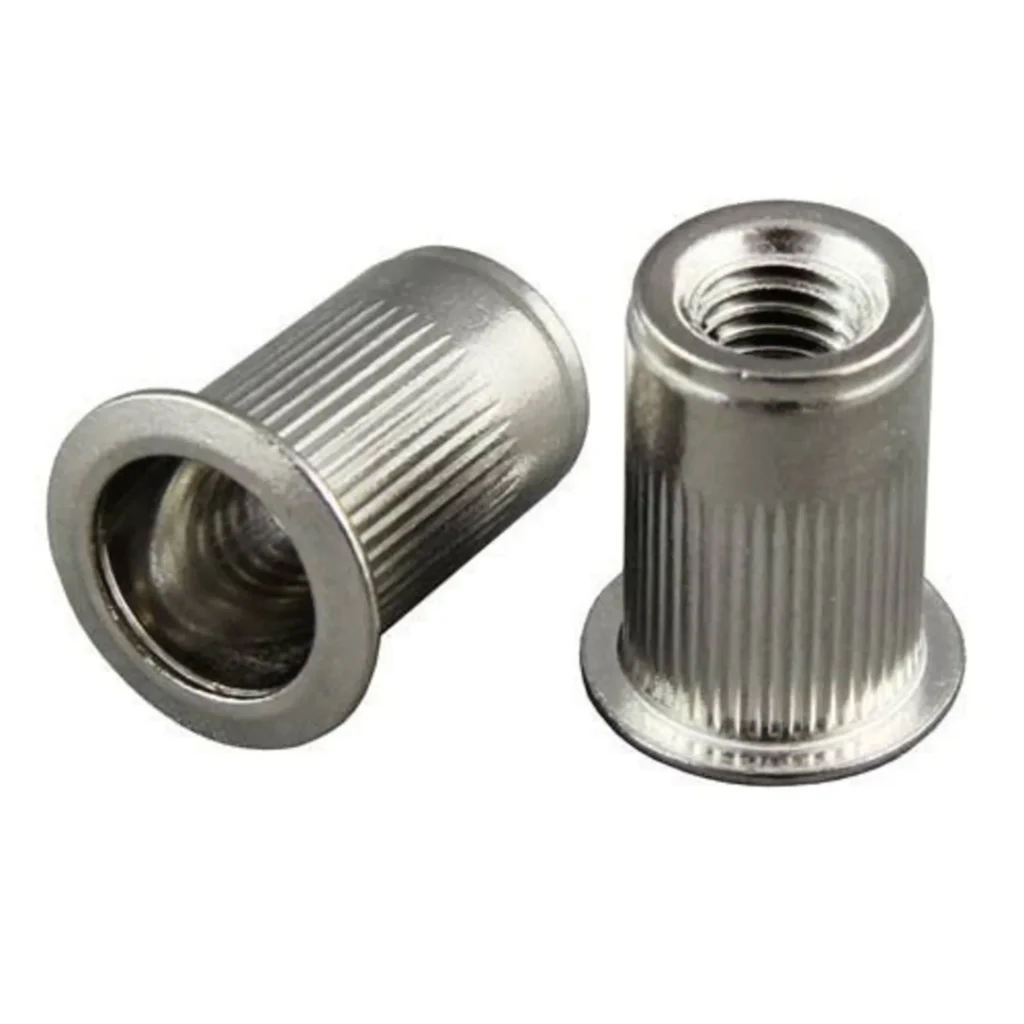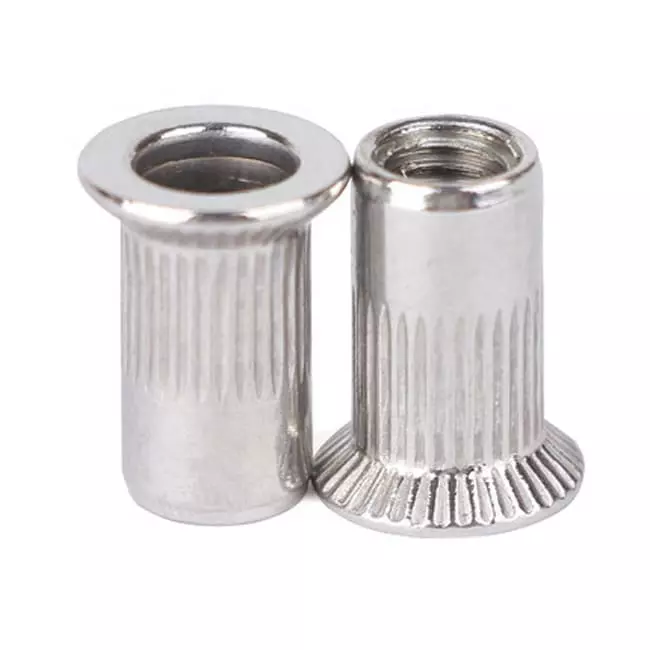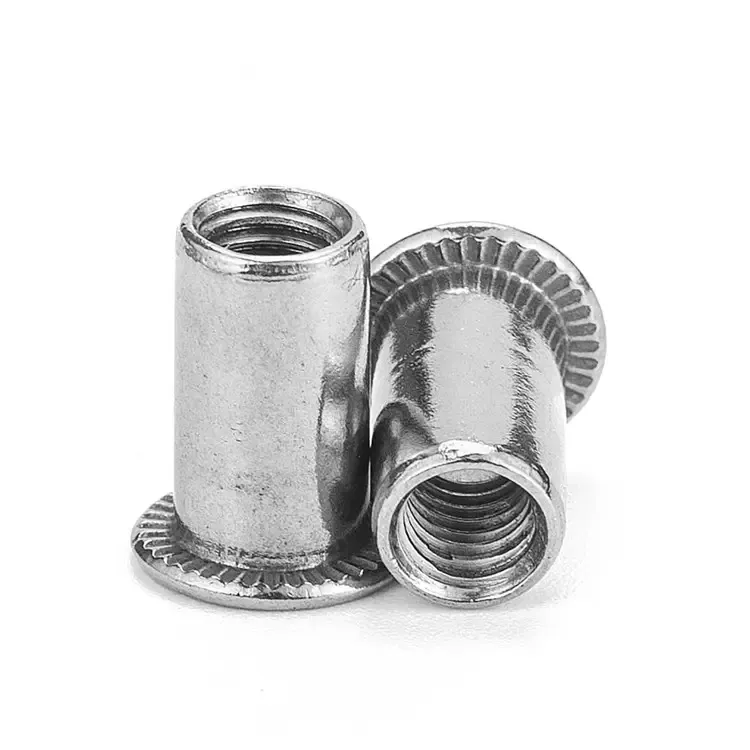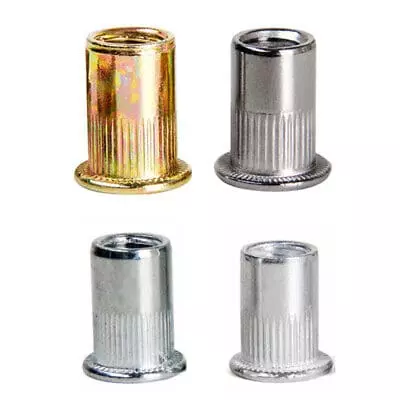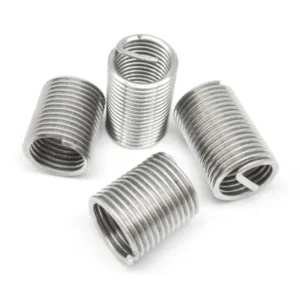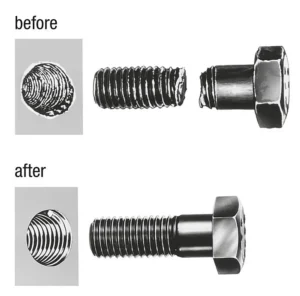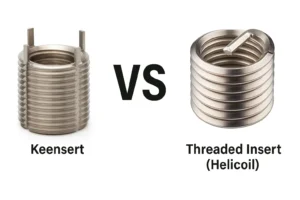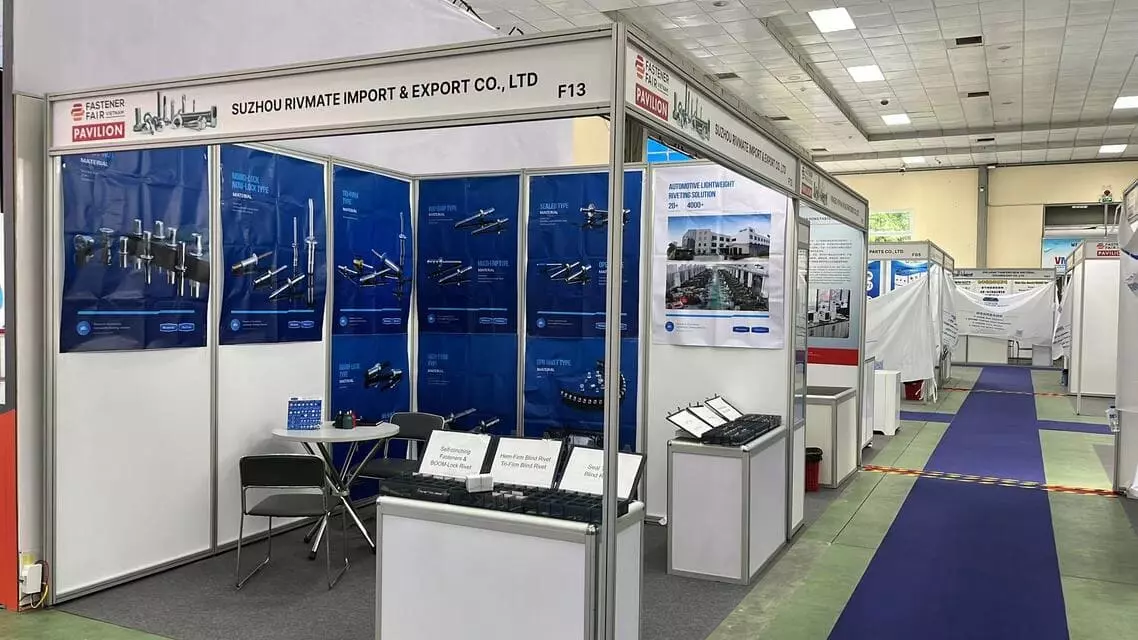Threaded Rivet Nuts Designed for Thin Materials & Blind Applications
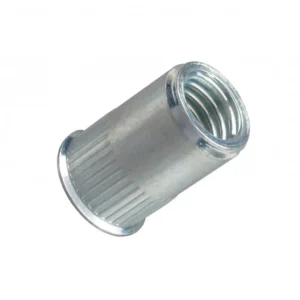
Leading Rivet Nut Manufacturer and Supplier in China
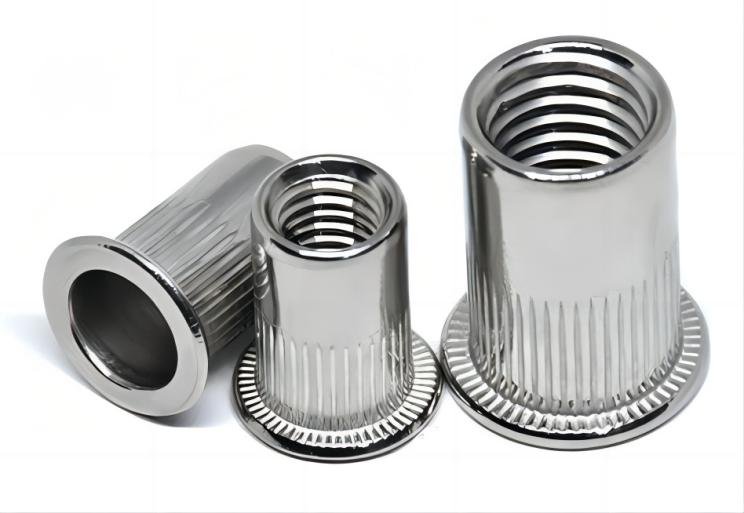
Threaded rivet nuts provide a reliable solution for fastening in thin materials and blind applications, where traditional nuts and bolts are impractical. Designed for secure, high-strength threading, they are ideal for automotive, aerospace, electronics, and construction industries. Whether you need vibration resistance, easy installation, or durability, threaded rivet nuts ensure a strong and lasting connection in limited-access areas.
Table of Contents
Why Use Threaded Rivet Nuts for Thin Materials?

Establishing reliable threaded connections on thin materials (such as metal sheets, plastics, composite materials, etc.) can be a challenge. Traditional welding or tapping methods may have various limitations, while rivet nuts (Rivet Nut) effectively solve these problems.
1. Challenges of Traditional Welding or Tapping Methods
(1) Limitations of Welding
- Potential for Material Damage: The high temperatures during welding may cause material deformation or embrittlement, especially for plastics and certain composite materials that cannot withstand high temperatures.
- Limited Applicability: Welding is primarily suitable for metal materials and cannot be used for non-metal materials, such as plastics or composite boards.
- Welding Quality Impact: Welding requires high precision; otherwise, the welded joint may lack strength or even develop cracks.
(2) Limitations of Tapping (Cutting Threads Directly into the Material)
- Thin Materials Can’t Form Effective Threads: If tapping is done on thin materials, the number of thread turns is limited, resulting in insufficient grip and making the threads prone to slipping or damage.
- Unable to Provide Strong Connections: For high-load applications or those requiring frequent disassembly, the threads created by tapping may not maintain stability over time.
2. Advantages of Rivet Nuts: Enhancing Thread Strength and Improving Assembly Efficiency
(1) Suitable for Thin Materials, Providing Reliable Threads
- Rivet nuts can create strong threaded connections on materials as thin as 0.5mm, allowing thin sheets to have high-strength threads.
- By using rivet deformation for fixing, the thread slipping problem caused by tapping is avoided, increasing the overall connection strength.
(2) Easy Installation, Improving Assembly Efficiency
- No Need for Welding or Pre-Tapping: Rivet nuts can be installed directly through riveting, without the need for welding equipment or tapping processes.
- Single-Sided Installation: Riveting can be completed from one side of the material, with no need to access the back, making it especially suitable for pipes, closed profiles, or other hard-to-reach workpieces.
- Suitable for Mass Production: Using pneumatic or electric rivet nut guns, installation can be done quickly, improving production efficiency and reducing labor costs.
(3) Enhanced Connection Strength and Durability
- Once installed, rivet nuts create permanent threaded connections capable of withstanding significant tensile and shear forces, making them suitable for various mechanical and structural applications.
- High-strength materials (such as stainless steel or carbon steel) can be used to enhance durability, making rivet nuts suitable for vibration and high-load environments.
(4) Suitable for Various Materials
Rivet nuts are not only suitable for thin metal sheets but can also be used for:
- Plastics (such as ABS, PC materials): Avoids thermal damage during welding while providing stable threaded connections.
- Composite Materials (such as carbon fiber boards): Does not damage the material structure while providing high-strength fastening.
3. Typical Application Scenarios
- Automotive Industry: Used for fixing body panels, internal decorations, and chassis connections.
- Aerospace: Suitable for fastening lightweight materials such as aluminum alloys and composites.
- Electronics: Used for securing plastic enclosures and heat sinks.
- Furniture Manufacturing: Suitable for structural connections in wood panels, laminated boards, etc.
Benefits of Threaded Rivet Nuts in Blind Applications
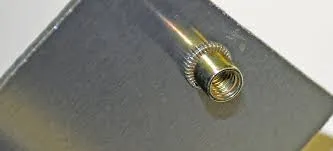
In many industrial and manufacturing applications, the backside of components may be inaccessible, such as in closed profiles, pipes, and box structures, where traditional threaded connections are difficult to implement. In these cases, rivet nuts (Rivet Nut) offer a highly efficient, reliable, and easy-to-install solution.
1. Suitable for Structures with Inaccessible Backside
In conventional fastening methods, the installation of bolts and nuts typically requires operations on both sides of the workpiece, such as passing the bolt through from the front and tightening the nut from the back. However, in many applications, the backside is inaccessible, such as in:
- Closed profiles (e.g., aluminum frames, steel pipe structures).
- Hollow pipes (e.g., bicycle frames, automotive chassis).
- Welded or monolithic box structures (e.g., cabinets, electronic enclosures).
In these cases, regular nuts or tapping methods cannot provide effective threaded fixation, but rivet nuts can create high-strength threaded connections inside blind holes through single-sided operation, enabling stable fastening even in complex structures.
2. Single-Sided Installation, No Back Support Needed, Enhances Assembly Flexibility
(1) Easy Single-Sided Operation
- Rivet nuts can be installed on one side only, with the use of a rivet nut gun to secure the nut, without the need to access or support the backside.
- This makes them suitable for various hard-to-reach structures like closed pipes, frame structures, and equipment enclosures, greatly enhancing the flexibility and feasibility of assembly.
(2) No Need for Back Support, Reduces Additional Structural Design
- In traditional bolt-nut connections, additional support points are often required on the back, such as welding nuts or adding thicker backplates, to ensure the nut doesn’t loosen.
- Rivet nuts do not require back support and can directly create strong threads in thin-walled materials or hollow structures, simplifying product structural design and reducing additional processing costs.
(3) Suitable for Thin-Walled Materials
- In blind hole structures, tapping cannot form strong enough threads. Rivet nuts, through deformation and riveting, securely fix onto thin-walled materials, without the issue of thread strength being affected by material thickness.
3. Suitable for Maintenance and Retrofit, No Damage to Original Structure
(1) No Welding, Avoiding Damage to Original Structure
- In certain scenarios, it may be necessary to add threaded fastening points to already installed equipment. If welded nuts are used, it may damage the original structure, causing material distortion or deformation.
- Rivet nuts can be installed without damaging the original structure, avoiding the heat-related damage and material deformation issues associated with welding.
(2) Facilitates Later Maintenance and Upgrades
- During the maintenance of equipment or products, if fasteners need to be replaced or adjusted, rivet nuts can be easily removed and replaced without affecting the surrounding structure.
- This makes them suitable for situations that require regular inspections, component replacements, or retrofitting, such as industrial equipment, automotive repairs, and aerospace components.
4. Summary: Why are Rivet Nuts Suitable for Blind Hole Applications?
| Comparison Factor | Traditional Nut + Bolt | Tapping | Rivet Nut |
| Installation Method | Requires double-sided operation | Requires thicker material support | Single-sided installation |
| Backside Accessibility | Requires access to the backside | Requires sufficient thickness to form threads | Suitable for structures with inaccessible backs |
| Material Impact | May require additional support points | Thin materials prone to thread stripping | Suitable for thin-walled materials and hollow structures |
| Maintenance & Retrofit | May require structural damage | Difficult to modify after tapping | Removable, replaceable, suitable for retrofit |
Types of Threaded Rivet Nuts for Thin Materials
When using rivet nuts on thin materials such as metal sheets, plastics, and composites, different types of rivet nuts vary in installation methods, clamping force, anti-rotation capability, and surface flatness requirements. Choosing the right type of rivet nut can optimize fastening performance, enhance connection stability, and increase durability. Below are several main types of rivet nuts suitable for thin materials and their characteristics.
1. Flat Head vs. Countersunk Head
The head design of a rivet nut affects its adaptability to the material surface. The two common types are Flat Head and Countersunk Head.
- Characteristics:
- The larger head provides a wider contact area, dispersing pressure and reducing the risk of material damage.
- Suitable for thin or softer materials, such as aluminum sheets, plastics, fiberglass, etc., preventing deformation or tearing of the material during fastening.
- After installation, the nut head slightly protrudes, making it suitable for applications where surface flatness is not critical.
- Applications:
- Electronic device enclosures (providing a larger contact area to prevent deformation of plastics or thin metals).
- Automotive sheet metal parts (enhancing connection strength and preventing tearing of the sheet).
- Characteristics:
- The head is cone-shaped, allowing it to sit flush with the material surface after installation, improving aesthetics.
- Suitable for applications requiring a smooth surface, such as when the external side needs to be flush with other components after installation.
- Generally used for metal materials, but for softer materials like plastic or fiberglass, a suitable countersunk hole may need to be pre-drilled to ensure better installation.
- Applications:
- Aerospace, precision instruments (strict requirements for surface flatness).
- Decorative panels, furniture manufacturing (avoiding protrusion of the nut head that would affect appearance).
2. Round Body vs. Hex Body
The body shape of the rivet nut affects its anti-rotation capabilities, with round body and hex body being the common designs.
- Characteristics:
- Simple structure, easy to manufacture, and suitable for most standard applications.
- Ideal for light loads or low vibration environments, such as general industrial equipment or household appliances.
- Due to its round shape, it may rotate in high torque or high vibration applications, affecting thread stability.
- Applications:
- Appliance manufacturing (such as air conditioners, washing machines) (does not require high anti-rotation capability).
- Light-duty machinery (lower thread load capacity, no additional anti-rotation design needed).
- Characteristics:
- The hexagonal design effectively prevents rotation, especially more stable in high vibration or high torque environments.
- Requires pre-punched or processed hexagonal installation holes in the material to ensure the best anti-rotation effect.
- Suitable for structures that experience larger shear or tensile forces, such as automotive or mechanical equipment.
- Applications:
- Automotive industry (engine compartments, chassis) (high vibration environment, preventing fastener loosening).
- Industrial equipment, heavy machinery (high load and strength requirements).
(1) Characteristics of Knurled Rivet Nuts
- The surface has knurling texture, which can increase friction between the rivet nut and the material, reducing the risk of loosening.
- Suitable for smooth or low-friction materials (such as aluminum alloys, plastics, and composites).
- Compared to regular round body rivet nuts, the knurling design enhances anti-rotation capability, though it is not as stable as the hex body design.
(2) Applications
- Plastic or composite material structures (to prevent loosening or rotation of the rivet nut during use).
- Applications requiring increased friction (such as high-vibration environments or lightweight structures).
4. Comparison of Rivet Nut Types for Thin Materials
| Category | Rivet Nut Type | Main Advantages | Applications |
| Head Design | Flat Head Rivet Nut | Provides a larger contact area, prevents material deformation | Electronic devices, automotive sheet metal |
| Countersunk Head Rivet Nut | Flush surface, improves aesthetics | Precision instruments, decorative panels | |
| Body Shape | Round Body Rivet Nut | Simple structure, suitable for general applications | Appliances, light-duty machinery |
| Hex Body Rivet Nut | Prevents rotation, suitable for high-vibration environments | Automotive, heavy machinery | |
| Special Design | Knurled Rivet Nut | Increases friction, reduces loosening | Plastics, composite materials |
Do You Have Any Questions?
Let Us Solve Your Problem
How to Select the Right Rivet Nut?
1. Material Type
The material of the rivet nut directly affects its strength, corrosion resistance, and application suitability. Common materials include:
- Characteristics:
- Lightweight, ideal for weight-sensitive applications (e.g., aerospace, electronics).
- High corrosion resistance, suitable for humid or corrosive environments.
- Lower strength compared to steel, not suitable for high-load applications.
- Best Applications:
- Lightweight structures, electronic enclosures, aluminum frames.
- Characteristics:
- Higher strength, suitable for most industrial applications.
- Cost-effective with good mechanical properties.
- Requires additional corrosion protection (e.g., zinc or nickel plating).
- Best Applications:
- Machinery, automotive, construction installations.
- Characteristics:
- Superior corrosion resistance, ideal for humid, high-salinity, or chemical exposure environments.
- High strength, making them suitable for heavy-load applications, but more expensive.
- Due to higher hardness, installation may require more force or specialized tools.
- Best Applications:
- Marine, outdoor equipment, food processing, medical devices.
2. Load Requirements
The right rivet nut should match the tensile, shear, and vibration resistance requirements of the application.
(1) Low-Load Applications
- Recommended Type: Round Body Rivet Nut or Flat Head Rivet Nut.
- Best Applications:
- Electronics, lightweight frame structures, plastic housings.
(2) Medium-Load Applications
- Recommended Type: Knurled Rivet Nut, which increases friction and prevents loosening.
- Best Applications:
- Home appliances, general machinery, automotive interior fastenings.
(3) High-Load Applications
- Recommended Type: Hex Body Rivet Nut, which prevents rotation and provides higher torque resistance.
- Best Applications:
- Automotive chassis, industrial equipment, structural assemblies.
3. Installation Environment
Selecting the appropriate rivet nut based on the application environment helps extend service life.
(1) Is Corrosion Resistance Required?
- Outdoor, humid environments (e.g., marine, construction) → Stainless steel rivet nuts.
- Indoor, dry environments (e.g., home appliances, furniture) → Carbon steel or aluminum rivet nuts with zinc/nickel plating for added protection.
(2) Is High Vibration Present?
- High-vibration environments (e.g., automotive, railway, industrial machinery) → Hex body or knurled rivet nuts to prevent loosening.
(3) Is Installation Space Limited?
- Blind-hole applications where access to the backside is impossible → Blind rivet nuts, which can be installed from one side.
- Select Based on Material:
- Aluminum → Lightweight & corrosion-resistant.
- Carbon Steel → Cost-effective & suitable for most industrial uses.
- Stainless Steel → Superior corrosion resistance & best for outdoor/wet environments.
- Select Based on Load Requirements:
- Low Load → Round Body Rivet Nut.
- Medium Load → Knurled Rivet Nut.
- High Load → Hex Body Rivet Nut.
- Select Based on Installation Environment:
- Outdoor/Wet Conditions → Stainless Steel Rivet Nut.
- High-Vibration → Hex Body Rivet Nut.
- Blind Hole Installation → Blind Rivet Nut.
Installation Methods & Tool Selection
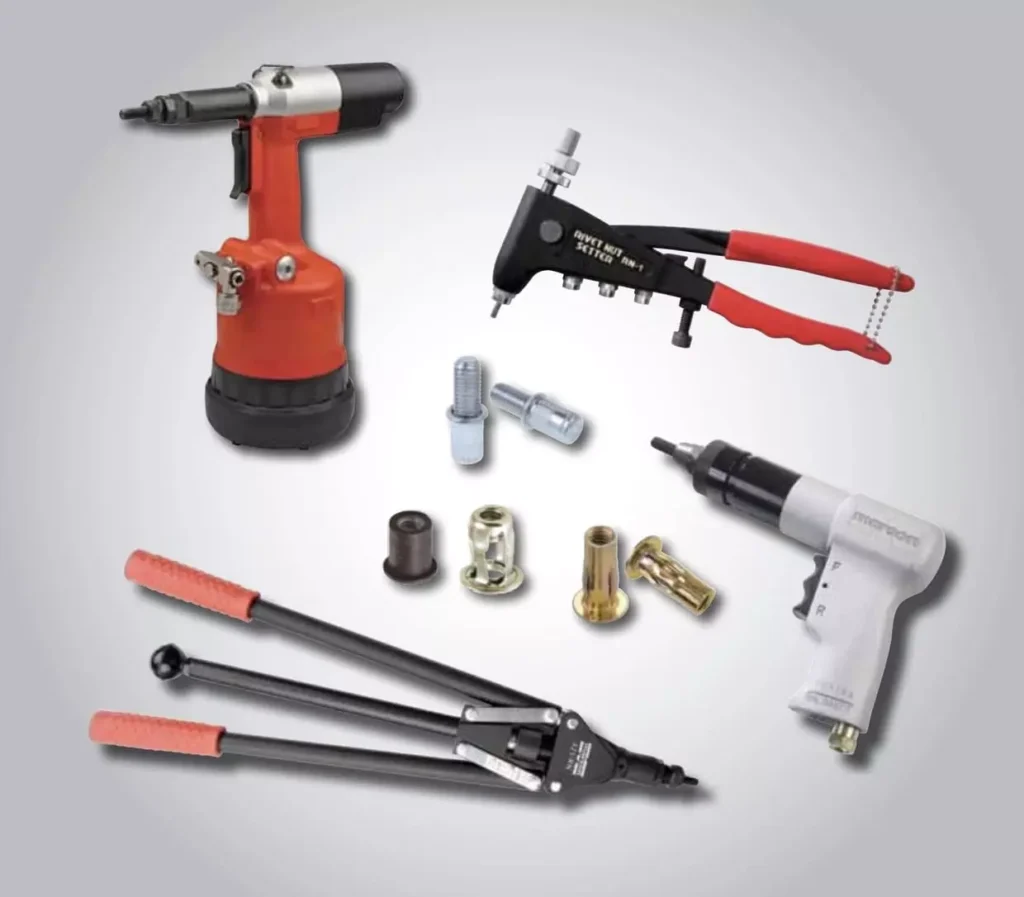
Manual rivet nut guns are suitable for small-scale assembly, requiring no power or air supply. They are cost-effective, portable, and ideal for repairs or DIY projects. However, manual operation is less efficient, not suitable for large-scale production, and requires skill to ensure proper installation.
Electric rivet nut guns offer higher installation efficiency, providing uniform pulling force and reducing human error. They are ideal for medium-scale production and repetitive operations, reducing labor intensity. However, they require an initial investment and access to a power source, making them unsuitable for environments without electricity.
Pneumatic rivet nut guns are the best choice for large-scale production, offering fast installation speed and consistent pulling force. They are ideal for installing high-strength rivet nuts (e.g., stainless steel rivet nuts). Despite their high cost and reliance on an air supply, they are widely used in industries such as automotive manufacturing and industrial production.
2. Proper Installation Method for Rivet Nuts
To ensure the strength and durability of rivet nuts, proper installation procedures should be followed to prevent common installation failures.
Standard Installation Steps:
- Select the appropriate rivet nut and installation tool, ensuring compatibility with the workpiece hole diameter.
- Drill the hole and deburr it to prevent burrs from affecting the rivet nut’s fit.
- Attach the rivet nut to the rivet nut gun, insert it into the pre-drilled hole, and ensure it is fully flush with the workpiece surface.
- Activate the tool to set the rivet nut, allowing it to deform and lock into place.
- Inspect the installation quality, ensuring the rivet nut is secure without rotation or loosening, and test the thread smoothness.
3. Preventing Common Installation Failures
Rotation Failure
Occurs when the rivet nut is not fully set or when the hole diameter is too large, causing the nut to spin inside the hole. Solutions include applying sufficient pulling force during installation, using knurled or hex-shaped rivet nuts to enhance anti-rotation capability, and ensuring proper hole sizing.
Pull-Out Failure
Common in soft materials or when the grip length is too short, leading to the rivet nut pulling out under tension. Solutions include using bulb-type (jack) rivet nuts for stronger grip, selecting longer rivet nuts for better fixation, and adding a backing plate or washer for thin materials.
Thread Damage
Can result from excessive force, soft material selection, or mismatched screw specifications. Solutions include choosing rivet nuts made from suitable materials (such as stainless steel or carbon steel), avoiding over-tightening, and using thick-walled rivet nuts for enhanced durability.
4. Conclusion
- Select the right tool: Manual tools for small batches, electric tools for medium-scale production, and pneumatic tools for large-scale manufacturing.
- Follow proper installation steps: Ensure accurate drilling, full contact of the rivet nut with the surface, and proper pulling force during setting.
- Prevent installation failures: Choose the correct rivet nut shape and specifications to avoid rotation, pull-out, or thread damage.
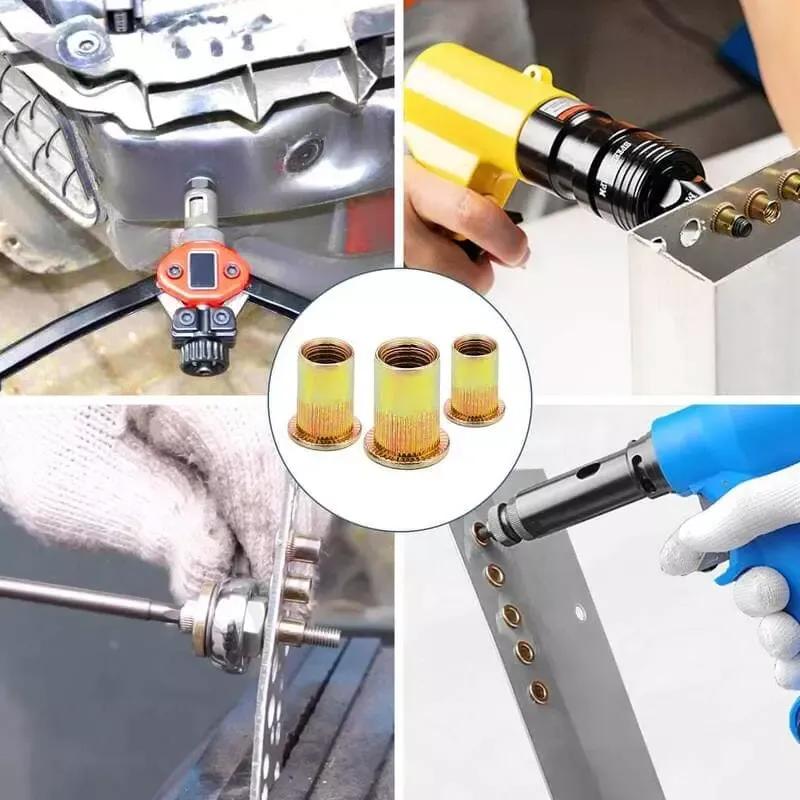
1. Main Applications of Rivet Nuts
- Threaded Fastening in Thin-Walled Materials: Provides a stable threaded connection in thin metal sheets, plastic parts, and composite materials where direct tapping is difficult.
- Blind Hole Installation: Suitable for closed profiles, tubes, and other structures where access to the backside for nut installation is not possible.
- Repairs and Modifications: Allows the addition of threaded connections without damaging existing structures, making them ideal for equipment repairs and additional installations.
- Vibration-Resistant and High-Strength Applications: Certain rivet nuts (such as knurled or hexagonal rivet nuts) enhance anti-rotation and vibration resistance, making them suitable for high-load or vibration-prone environments.
2. Key Industry Applications
(1) Automotive Manufacturing
Rivet nuts are widely used in the automotive industry for securing body panels, chassis components, and engine compartments. Examples include:
- Assembling car doors and dashboards, providing a lightweight and strong threaded fastening method.
- Fixing exhaust systems, brackets, and seats, where vibration resistance is essential.
(2) Rail Transit
In high-speed rail, subways, and buses, rivet nuts are used to secure interior structures such as seats, soundproof panels, and ceilings, improving assembly efficiency while ensuring long-term stability.
(3) Aerospace
In aircraft and spacecraft, where lightweight and high-strength materials are essential, rivet nuts are commonly used to fasten aluminum skins, electronic equipment brackets, and cabin interiors, providing reliable threaded connections while reducing structural weight.
(4) Electronics and Home Appliances
In the manufacturing of laptops, televisions, computer cases, and household appliances, rivet nuts are used to secure thin-walled metal or plastic enclosures, ensuring stronger screw fastening and enhancing product durability.
(5) Construction and Machinery Manufacturing
- Used in curtain walls and steel structures to provide additional threaded fastening points.
- Applied in machinery assembly to enhance structural strength and fastening reliability, reducing the risk of loosening due to vibrations.
Do You Have Any Questions?
Let Us Solve Your Problem
Buy Rivet Nuts from Rivetfix
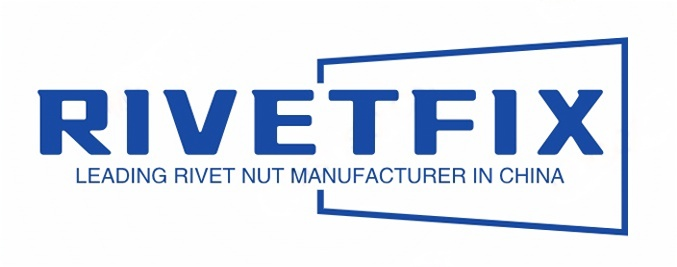
As a leading fastener manufacturer in China with more than 15 years in the industry, Rivetfix are committed to providing first-class quality fasteners and responsive services to the world.
Rivetfix offers a wide range of rivet nuts and rivet nut tools designed to meet the unique demands of your projects. Rivetfix ensures you have the right solution for every application. Choose Rivetfix for versatile, cost-effective, and durable fastening solutions tailored to your specific needs. In addition, we can also provide customized rivet nuts service according to your requirements.
Contact us for project advice and the latest rivet nuts and rivet nut tools quote!
Get High Quality Rivet Nuts Quote!
Send Your Rivet Nut Request
For more than 20 years, Rivetfix has helped customers solve many rivet nuts sourcing needs and technical challenges.
Have a question? Contact us and we’ll provide you with the perfect solution.

